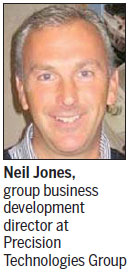Acquiring knowledge, building strength
Updated: 2015-09-05 07:42
By Cecily Liu(China Daily Europe)
|
|||||||||||
However, the company's R&D activities extend beyond this center, because it is also using its European sales force as a way of gathering information on customer needs, which is then used by its R&D centers in China to further develop products, says Su Lei, country manager for Mindray UK.

R&D is at the heart of Mindray's corporate culture because technology in the medical industry advances rapidly, Su says, and the company needs to keep up with the latest trends in the industry to stay ahead of its competitors.
Mindray consistently invests 10 percent of its annual sales revenue in R&D, which is high by industry standards. The company's R&D team accounts for about one-third of the total workforce.
The R&D center in Sweden has great expertise in anesthesia monitoring devices, Su says. "We greatly value this R&D center from a strategic perspective, and we use it to research pioneering technology in relation to the medical industry because Europe has an advantage in breakthrough technology research."
Mindray's R&D centers in China focus more on developing new products and commercializing technology for production. There is strong collaboration between the team in Sweden and the Chinese R&D centers, Su says.
As with Mindray's access to R&D capability in anaesthesia through the Datascope acquisition, the 2008 purchase by the Chinese company Zhuzhou CSR Times Electric of the British semiconductor company Dynex Semiconductor Ltd has given it crucial R&D capability in chip technology, which is crucial for the railway industry.
That helped it develop its own version of a high-efficiency switch called an insulated-gate bipolar transistor, a key transport industry component.
Zhuzhou CSR Times Electric was part of railway equipment manufacturer CSR Corporation, which merged with another manufacturer, CNR Corporation in June, to create CRRC Corporation, and had imported these switches from leading international suppliers in Europe and Japan for many years.
CSR wanted the competitive advantage of in-house competence in designing and making such semiconductor technology.
Paul Taylor, CEO of Dynex, says the acquisition has greatly helped his team increase its R&D capabilities through financial support, technology sharing and assistance with commercialization.
Since the acquisition, Dynex has expanded technologically in two stages. In the first phase, 7.8 million pounds ($12 million; 10.7 million euros) was invested in R&D starting in 2010, of which Zhuzhou CSR Times Electric contributed 80 percent. In the second phase, which began last year, 20 million pounds was invested in R&D, with 80 percent of that again coming from Zhuzhou CSR.
The investment has enabled Dynex to build a new R&D center, which opened in 2012. Dynex's R&D staff has grown from 12 before the acquisition to 55.
Taylor says the access to skilled engineers from Zhuzhou CSR Times Electric, who are seconded to Dynex, is also valuable for both the development of new technology and technology transfers from Dynex to Zhuzhou CSR.
"The fact that they have been here and understand the way we work as a team also means they can help to coordinate a lot of the partnership we have with our parent company in the longer term," he says.
More recently, Zhuzhou CSR Times Electric has set up a team of about 10 to conduct research and development on the drivetrain sub-assemblies of electric vehicles, which is based at Dynex's R&D center.
The new team will look into how the semiconductor switching technology they developed for trains can be applied to electric cars, hoping to develop a technology that can be sold to carmakers.
Today's Top News
Acquiring knowledge, building strength
Foreign bears don't affect China - yet
Austria to end messures letting migrants in
Ex-VP nominee Palin: Immigrants in US should 'speak American'
China 2014 GDP growth revised down to 7.3%
White paper on Tibet reaffirms living Buddha policy
Austria, Germany open borders to migrants
PBOC governor says stock market correction roughly in place
Hot Topics
Lunar probe , China growth forecasts, Emission rules get tougher, China seen through 'colored lens', International board,
Editor's Picks

|

|

|

|

|

|






